
MOD70 Spindrift Flips During Inshore Race
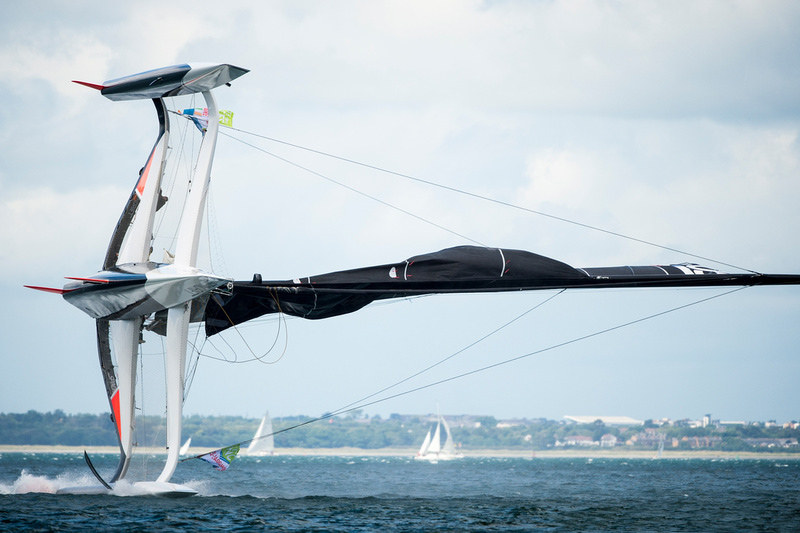
In the upcoming July issue of Latitude 38, we give two reasons for preferring MOD70 trimarans over AC72s for the America’s Cup. The first is cost. Because the MOD70s have soft sails and are a strict one design, they can be built and maintained for a fraction of the cost of just the wing sail for an AC72 catamaran. The second reason is that because MOD70s are longer, depowered versions of the ORMA 60 tris and, because they have safely raced across the Atlantic at higher speeds than any vessel under 100 feet, they would seem to be less likely to flip than the 72s. But, as we clearly stated, this doesn’t mean MOD70s are immune to flipping.
As if to prove our point, on June 22, Spindrift, one of seven MOD70s built to date, flipped during one of the La Route des Princes inshore races off Dun Lagohaire. It was the first time a MOD70 has flipped. Unlike the tragic flipping of the AC72 Artemis on San Francisco Bay, skipper Yann Guichard didn’t hesitate to explain exactly what happened:
"We had 22 to 24 knots of wind at the start line with gusts up to 30 knots at the lower end of the course. We were at the limit of weather conditions for our boats, and it was not great for racing. All the MODs had one reef in the main and staysail. We started a bit below and behind the fleet, and found ourselves slightly in a wind shadow. When our rivals had moved away, we had a sudden gust that flattened us. I was unable to do anything at the helm, the boat was turned over in a single blow. We let out the staysail immediately, but it was too late as it all happened in a split second. The boat was lifted onto the port float and went over. Jacques [Yann’s brother] was with me in the cockpit and we found ourselves in the net. We managed to get out and then were airlifted. The mast broke in two when Spindrift turned over. The frame of the trimaran was towed away to port."
Jacques suffered a broken pelvis.
As reported in a recent ‘Lectronic, the Wanderer and Doña de Mallorca sailed aboard the MOD70 Orion on Banderas Bay at speeds up to 35 knots in true wind of about 20 knots. The thing that puzzled us was that you could only ease the mainsheet about three feet. When we sailed on Steve Fossett’s ORMA 60 Lakota years ago, we’d also been surprised at how short the mainsheet was, although as we remember, it was somewhere between eight and ten feet long. Based on the above video of the accident, it doesn’t seem to us that the trimaran flipped in a "split second," and that had there been a ‘panic button’ to instantly release the mainsheet, as there was on Lakota, it’s possible that the trimaran could have been kept from flipping. But clearly nobody can guarantee that any of these high performance multihulls won’t flip.
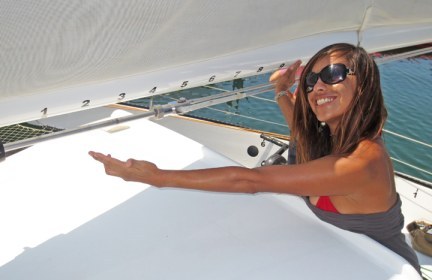
©2013 Latitude 38 Media, LLC
The danger with big racing multihulls is, of course, not that they will sink, but that members of the crew will be hurt falling from high above the water onto a hard surface, or that they will be trapped under the nets.
Unresolved Issues for AC 34
Sadly, in the modern era of America’s Cup racing, contentiousness between competitors off the water has sometimes been more explosive than on the race course. America’s Cup 34 seems to be following that trend.
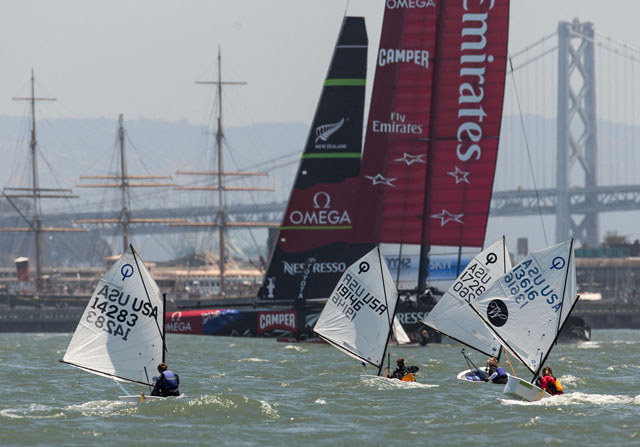
Today, a mere two weeks before the first scheduled race, the three challenging teams (Emirates Team New Zealand, Luna Rossa Challenge, Artemis Racing) and the defender (Oracle Team USA) are in a deadlock over proposed rule changes. After four days of formal arbitration last week with two international sailing judges, "a couple of points" are still unresolved.
While that language sounds only minimally troubling, some Cup experts believe the teams are so firmly entrenched in their positions, that the matter may end up in a New York (home of the original Deed of Gift) courtroom. Adding to the uncertainty is the fact that Regatta Director Iain Murray has already submitted all 37 safety recommendations in question to the Coast Guard as part of the Marine Event Permit application, yet given the specificity of the rules previously established for AC 34, there is some question as to whether Murray has the authority to demand such changes and enhancements.
For those readers who are less than obsessed with all things AC, let us clarify the backstory: In the aftermath of the death of Artemis crewman Andrew Simpson on May 9, a special panel of experts was formed to study the tragedy. The 37 recommendations mentioned above resulted from the panel’s findings.
Although the America’s Cup Event Authority (ACEA) has not specified which recommendations are at issue, several news sources have revealed that the proposed addition of "rudder elevators" to the AC72s is the most hotly contested issue. You won’t find that term in a basic sailing book, but in plain English it refers to adjustable horizontal trim tabs that would be added to each rudder in order to help stabilize the AC72s when foiling.
The way we understand it, the original AC72 class rules call for fixed angles for daggerboard foils and rudders. But being able to actively adjust the angle of attack of those elements would seem to be a good thing, as running without them would be like trying to take off and land a plane without flaps. However, conjecture on the docks is that Emirates and Luna Rossa are objecting because they have apparently developed methods to control their boats without rudder elevators, even when hydrofoiling. Furthermore, because Artemis doesn’t expect to be ready to compete until late July, and Oracle Team USA won’t have to face any boat in competition until the actual America’s Cup begins in early September, those teams would have an unfair length of time for development and experimentation before competing.
Yeah, it’s a mess. But with so many millions of dollars invested thus far, we can only hope that an 11th-hour compromise can be agreed to, so the show can go on as planned.
On a brighter note, shoreside infrastructure is ready to receive thousands of Cup fans for the opening day ceremonies on July 4. There’s all sorts of cool stuff to check out there, including poster signings with the crews, films, and official merchandise. Also, the newly constructed performance venue at Piers 27/29 has already held several sold-out shows, and upcoming acts are expected to be equally successful.
The much-anticipated July 5 fleet race appears on the just-released schedule of first week events, and if they actually run it, it may prove to be one of the most thrilling parts of the whole summer’s calendar, as it will be the one and only AC72 fleet competition of the summer. (Fleet races during last summer’s AC World Series proved much more thrilling for spectators than match racing.)
According to the master schedule, the first race of the Louis Vuitton challenger series will be July 7, between ETNZ and LRC. Although both July 9 and 11 are titled ‘race days’, even in the latest schedule, mention of an actual contest is absent on those days. By contrast, the master calendar shows Artemis vs ETNZ on the 9th, and Artemis vs LRC on the 11th, but the Swedish team has already made it clear that they will be a no-show. Our understanding is that their would-be opponent would still have to run the course to score a win, but at this point, it’s anybody’s guess if that’s still true. Meanwhile, pre-sold tickets for all races through the Louis Vuitton Semi-Finals have been refunded. Stay tuned for updates and more schedule changes — no doubt there will be plenty of them.
AYSF Team Attempt Rescue
A tragedy unfolded Friday afternoon when a woman’s minivan careened across Marina Green and into the frigid waters of San Francisco Bay. At Golden Gate YC, the American Youth Sailing Force — the local Red Bull Youth America’s Cup team — were getting ready for a fundraising mixer at the club when the accident occurred.
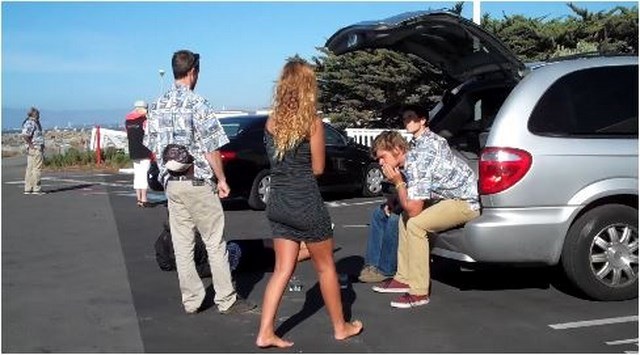
Almost immediately, several of the young men jumped into the team’s Protector to attempt a rescue, but by the time they arrived on scene, the minivan was already nose down and sinking fast. "When we saw the van in the water, our first thought was we’ve got to go help" said Ian Andrewes, sailing team manager. In the minute or two it took to reach the van, three of the team had stripped off their dress clothes and jumped in the water.
A video aired in KGO Channel 7’s news report showed three of the team perched on the back of the van trying to pound out the rear window. They also made several free dives to try to pull the woman free. Sadly, they were unsuccessful.
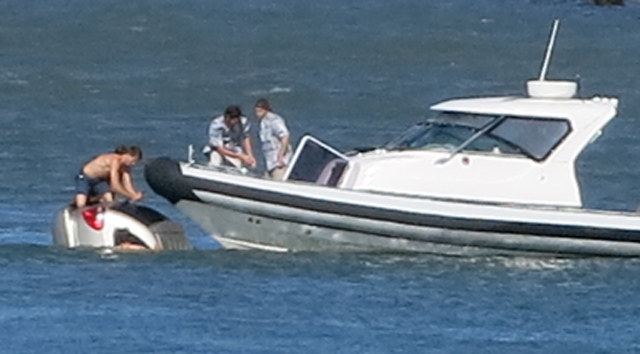
It took several hours for rescue assets from the San Francisco Fire and Police Departments to locate the van but by then conditions forced a delay in recovering the van and its sole occupant. The body of Debra Crenshaw, 60, was retrieved the next day and the vehicle removed from the Bay. The cause of death has not yet been released.
As tensions mount between the big boys in the America’s Cup, the fine young men of the Youth AC exemplify what true seamanship is all about.
